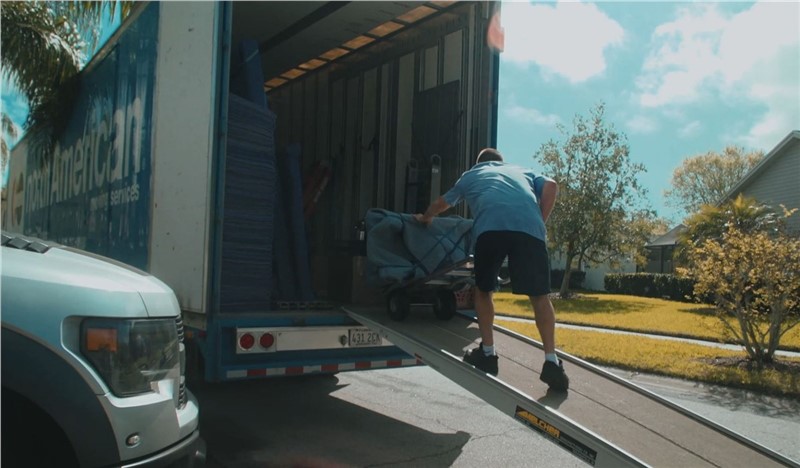Understanding the Inclusions of moving and Freight Forwarding in the Globe of Residential and International Delivery
Guiding via the intricacies of moving and Freight forwarding can be challenging. Both processes entail distinctive treatments and needs that are essential for effective transportation. Comprehending the distinctions in logistics, documents, and threat management is important for services and individuals alike. This expertise can significantly affect the effectiveness and safety and security of deliveries. Several are unaware of the details elements that influence the total experience and end results. What factors should one think about to guarantee a smooth transition?
The Fundamentals of moving and Freight Forwarding
moving and Freight forwarding are basic elements of the worldwide logistics sector. They help with the transfer of goods and individual valuables throughout international and residential borders. moving primarily involves the relocation of people or family members, incorporating business and domestic demands. It typically consists of packing, packing, carrying, and unboxing products at the destination. In contrast, Freight forwarding is concentrated on the delivery of goods, frequently wholesale, utilizing different transportation modes, such as land.freight, air, or sea forwarders serve as middlemans, coordinating logistics to assure prompt distribution while navigating via complicated regulations and customizeds treatments. Both procedures need mindful planning, company, and interaction to ensure efficiency and reduce interruptions. Recognizing these fundamentals is important for any person associated with logistics, as they prepared for advanced facets of shipping and transportation management.
Key Parts of Freight Forwarding Providers
Freight forwarding solutions encompass a number of important elements that ensure smooth transportation of products. Key duties of Freight forwarders include handling logistics, collaborating shipments, and taking care of custom-mades clearance. Additionally, understanding important shipping documentation is critical for compliance and reliable motion of cargo.
Freight Forwarder Responsibilities
A reputable Freight forwarder plays a necessary role in coordinating the transportation of goods, making certain that shipments are managed successfully and in compliance with regulations. Their duties encompass numerous crucial jobs, consisting of picking excellent transportation routes, working out Freight rates, and managing logistics. They work as intermediaries between carriers and shippers, guaranteeing that freight is appropriately packaged and labeled for secure transportation. In addition, Freight forwarders track deliveries, offering updates to customers regarding the status and anticipated shipment times. They additionally evaluate and manage threats related to transportation, suggesting insurance coverage alternatives as needed. By facilitating communication and paperwork, Freight forwarders simplify the shipping procedure, lowering possible delays and enhancing total supply chain performance.
Delivering Documentation Fundamentals

Recognizing Customs Clearance and Paperwork
Accurate paperwork is vital in the personalizeds clearance process, as it ensures conformity with numerous laws. A summary of personalizeds laws highlights the intricacies dealt with by shippers and Freight forwarders. Typical clearance obstacles can greatly affect delivery timelines and prices, making understanding this element crucial for effective logistics.
Relevance of Accurate Documents
Guiding with the intricacies of worldwide delivery needs a keen understanding of custom-mades clearance and the critical role of documentation. Exact paperwork is vital for making certain that shipments abide by guidelines and reach their destinations immediately. Effectively prepared papers, including expenses of lading, commercial billings, and packing lists, promote smooth communications with personalizeds authorities. Errors can result in delivery delays, fines, or even confiscation of goods. In addition, comprehensive paperwork aids in tracking shipments and settling conflicts. As a result, companies engaged in moving and Freight forwarding need to prioritize meticulous documentation practices to browse the detailed landscape of worldwide shipping efficiently. This diligence not just improves procedures yet also improves customer satisfaction by guaranteeing timely distribution.
Custom-mades Regulations Summary
Guiding personalizeds laws is a vital facet of global profession that directly impacts the success of moving and Freight forwarding procedures. Efficient custom-mades clearance needs an understanding of various guidelines, including tariffs, obligations, and import/export restrictions. Precise paperwork is necessary, as it guarantees conformity with legal demands and assists in the effective motion of items throughout borders. Key papers usually consist of commercial billings, packaging lists, and expenses of lading, which provide comprehensive info about the delivery. Additionally, customizeds brokers play an important role in steering complex regulations, serving as intermediaries in between customizeds and shippers authorities. By keeping extensive understanding of customizeds procedures, organizations can greatly reduce hold-ups and minimize costs associated with worldwide shipping.
Usual Clearance Challenges
Various challenges can arise throughout the personalizeds clearance process, typically making complex the activity of goods throughout boundaries. One considerable concern is inadequate paperwork, which can result in hold-ups and charges. Importers and exporters must guarantee all required paperwork, such as billings, packaging listings, and certifications of origin, is full and precise. Additionally, discrepancies in appraisal can cause analysis from customizeds authorities, leading to extra tasks or examinations. Language obstacles might also present challenges, as miscommunication can cause misconceptions concerning guidelines. In addition, adjustments in personalizeds guidelines can produce complication, necessitating continuous alertness by carriers. Eventually, getting over these clearance challenges needs comprehensive preparation and a clear understanding of customizeds needs to assist in smooth global purchases.
Product Packaging and Identifying Demands
Frequently neglected, packaging and labeling needs play an essential duty in the delivery procedure, ensuring that products are safeguarded and conveniently identifiable throughout their trip (international shipping). Appropriate product packaging safeguards products from damage during transportation, while likewise promoting Look At This efficient handling and storage space. Utilizing ideal products, such as bubble wrap, foam, or tough boxes, can protect against damage and loss.Labeling is just as crucial. Clear and precise tags share important details, consisting of the destination, taking care of instructions, and components. Labels should adhere to policies particular to domestic and international shipping, which might consist of hazardous materials identification or customs declarations.Moreover, standard labeling techniques simplify the monitoring process and improve general logistics performance. By sticking to packaging and labeling requirements, businesses lessen the threat of hold-ups, damage, or misdelivery. Ultimately, these practices add significantly to the success of moving and Freight forwarding operations, ensuring a smooth delivery experience for all celebrations included
Tracking Deliveries: Significance and Methods
Reliable product packaging and labeling set the structure for effective delivery monitoring, but tracking deliveries is similarly vital in the delivery procedure. Shipment tracking offers real-time exposure, which aids customers and organizations monitor the development of their items. This openness enhances customer complete satisfaction, given that customers can stay notified about shipment timelines and any type of potential delays.Several approaches help with reliable monitoring. Barcode scanning is an usual technique, utilizing one-of-a-kind identifiers to check plans throughout their trip. In addition, general practitioner modern technology allows precise area monitoring, permitting prompt updates and boosted logistics monitoring. Several shipping companies currently provide electronic systems and mobile applications that provide users with easy access to tracking information.The significance of shipment tracking can not be overemphasized; it minimizes the risk of lost or damaged goods, improves functional efficiency, and cultivates trust fund between shippers and recipients. For that reason, integrating effective monitoring techniques is essential for successful residential and worldwide delivery procedures.
Insurance policy Options for Your Product
Protecting insurance for goods in transit is an essential factor to consider for companies and people alike. Insurance policy alternatives vary based on the type of delivery, worth of products, and specific risks included. Usual types consist of copyright obligation, which covers loss or damages while en route, and full-value insurance policy, supplying substantial insurance coverage for the overall value of the goods.Shippers may likewise think about marine insurance for international shipments, safeguarding versus risks related to sea transportation. It is important to evaluate the certain requirements of the shipment and assess the terms of any kind of policy.Furthermore, comprehending exemptions and constraints is vital to avoid prospective voids in coverage. Shippers must involve with insurance policy professionals to explore customized solutions that fit their one-of-a-kind scenarios. Eventually, investing in the ideal insurance policy can mitigate monetary dangers and supply comfort during the delivery procedure.
Choosing the Right moving and Freight Forwarding Service
When picking a moving and Freight forwarding solution, it is important for people and services to meticulously assess their particular demands and top priorities. Variables such as the quantity of items, location, and timeline play a significant role in this decision-making procedure. Looking into various carriers is advisable; comparing their solutions, rates, and consumer evaluations can expose important insights.Additionally, it is needed to take into consideration the experience and proficiency of the service copyright in dealing with particular kinds of freight, particularly for global deliveries that might include personalizeds clearance. Openness in pricing, consisting of any type of concealed charges, must likewise be scrutinized.Furthermore, examining the degree of consumer support offered is vital, as prompt interaction can reduce issues throughout transit (lcl look at this now shipping). Validating the availability of insurance policy alternatives guarantees that products are protected throughout the delivery process. By taking these individuals, organizations and steps can make informed options that straighten with their logistics needs
Frequently Asked Inquiries
What Kinds Of Product Can Be Shipped Internationally?

How Do Shipping Costs Range Different Providers?
Shipping costs differ greatly between service providers as a result of factors such as solution speed, cargo kind, distance, and extra services supplied. Each service provider's pricing design shows these variables, affecting general delivery expenditures for consumers.
Can I Ship Hazardous Materials or Perishables?
Delivering harmful products and perishables goes through stringent regulations. Providers frequently call for specific packaging, labeling, and paperwork. Shippers have to assure conformity with regional and global regulations to prevent fines and ensure secure transportation.
What Should I Do if My Shipment Is Postponed?
When encountered with a shipment hold-up, one need to first get in touch with the provider for updates. Assess any kind of notices obtained, evaluate alternative solutions, and maintain all celebrations notified regarding the circumstance to lessen disruptions.
Are There Weight Purview for Shipping Containers?
Weight limitations for delivery containers vary depending on aspects like container size and shipping regulations. Typically, conventional containers have a maximum gross weight of around 30,000 to 32,000 kilograms to guarantee safe transport and handling. In contrast, Freight forwarding is concentrated on the delivery of products, often in bulk, using various transportation modes, such as sea, air, or land.freight forwarders act as intermediaries, working with logistics to guarantee timely shipment while maneuvering through complicated guidelines and custom-mades procedures. Secret responsibilities of Freight forwarders include taking care of logistics, collaborating shipments, Continued and managing customizeds clearance. A reliable Freight forwarder plays an essential role in coordinating the transport of products, making sure that deliveries are dealt with successfully and in conformity with regulations. Effective packaging and labeling set the structure for effective shipment management, but tracking deliveries is similarly necessary in the delivery procedure. Lots of delivery business now provide digital systems and mobile applications that supply customers with simple accessibility to tracking information.The significance of delivery monitoring can not be overstated; it reduces the risk of shed or harmed products, boosts operational performance, and promotes trust between recipients and carriers.
Comments on “Understanding air, sea, and land modes in shipping overseas”